As loving pet parents, we constantly strive to provide the best for our furry companions, and that often includes sharing our food. However, What Food Cannot Be Given To Dogs is a critical question every dog owner must understand. While some human foods are perfectly safe and even healthy for dogs in moderation, many common household items can be highly toxic, even in small amounts, leading to severe illness or worse. The unfortunate reality is that pet poisonings are a significant threat, with hundreds of thousands occurring annually in the United States alone. A substantial portion of these incidents are food-related, highlighting the urgent need for clear, accurate information.
Understanding the distinction between safe and unsafe foods is paramount for safeguarding your dog’s health. This comprehensive guide serves as your essential resource, detailing precisely what human food can dogs eat and not eat, helping you navigate potential dietary hazards. We’ll explore why certain foods pose a risk, provide an extensive list of items your dog should never consume, and offer practical advice on prevention and emergency responses. By arming yourself with this knowledge, you can ensure your beloved canine companion remains happy, healthy, and safe from harmful ingredients lurking in your pantry or on your plate. For a broader understanding of dangerous human foods, consider exploring what foods can dogs have and not have to ensure comprehensive pet safety.
Why Certain Foods Are Toxic to Dogs
The digestive and metabolic systems of dogs are significantly different from those of humans. This fundamental physiological distinction explains why many foods that are harmless or even beneficial for us can be incredibly dangerous for our canine friends. Dogs’ bodies process certain substances in unique ways, often leading to toxic accumulation that wouldn’t occur in humans.
For instance, the methylxanthines found in chocolate, such as theobromine and caffeine, are metabolized much slower by dogs. This slower breakdown means these toxic compounds can build up to dangerous levels in a dog’s system more rapidly than in a human’s, potentially leading to severe health complications and even fatalities. Similarly, while the fleshy parts of fruits like cherries might seem innocuous, their pits, stems, and leaves contain cyanide. Although a large quantity would be needed to cause acute cyanide poisoning, the pits themselves can also be a choking hazard or cause gastrointestinal upset and blockages due to their indigestibility. Therefore, it’s generally best to avoid feeding these to your dog entirely.
The degree of food toxicity can also vary based on several factors unique to each dog, including their size, breed, age, and existing health conditions. A small breed dog, for example, may exhibit severe symptoms from an amount of a toxic food that might only cause mild discomfort in a much larger dog. Puppies and elderly dogs, with their less developed or potentially compromised systems, can also be more susceptible to adverse reactions. This variability underscores the importance of consulting with your veterinarian if you have any questions or concerns about specific foods or if your dog accidentally ingests something questionable. Knowing what dog food not to feed dogs is crucial for proactive care.
Comprehensive List of Foods Dogs Cannot Eat
Many common household foods, often considered treats or staples in human diets, are dangerous—and frequently toxic—to dogs. It’s vital for pet owners to recognize these risks to prevent accidental poisoning. While this list details what a dog cannot eat, it’s important to remember it’s not exhaustive, and vigilance is always necessary.
1. Alcohol
 Dangerous alcoholic drink next to a playful dog, highlighting harmful human foods for pets.
Dangerous alcoholic drink next to a playful dog, highlighting harmful human foods for pets.
Due to their smaller body size and differing metabolic rates compared to humans, alcohol can have a much more profound and potentially deadly effect on dogs. Even minimal amounts can cause significant harm. The smaller the dog, the greater the danger posed by even a tiny sip. Symptoms of alcohol poisoning in dogs mirror those in humans, including vomiting, disorientation, breathing difficulties, coma, and can ultimately lead to death.
2. Apple, Apricot, Cherry, Peach, and Plum Seeds/Pits
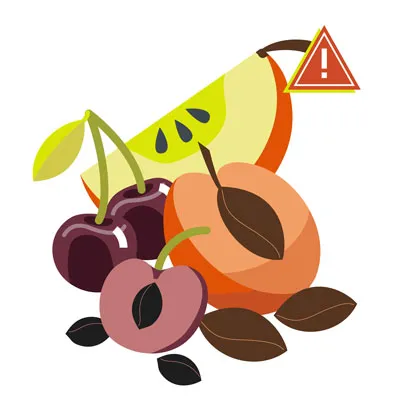 Variety of fruit seeds and pits, emphasizing the risk of cyanide poisoning for canines.
Variety of fruit seeds and pits, emphasizing the risk of cyanide poisoning for canines.
While the fleshy parts of apples can be safe and even healthy for dogs, their cores and seeds are not. Apple seeds contain cyanide. Although small amounts might not immediately cause issues, it’s safest to avoid the core and seeds entirely. The pits from apricots, cherries, peaches, and plums also contain cyanide. Ingestion can lead to severe symptoms such such as vomiting, an irregular and rapid heartbeat, seizures, coma, and even death, as cyanide interferes with the red blood cells’ ability to carry oxygen. Furthermore, the hard pits themselves pose a choking hazard and can cause gastrointestinal obstructions.
3. Avocado
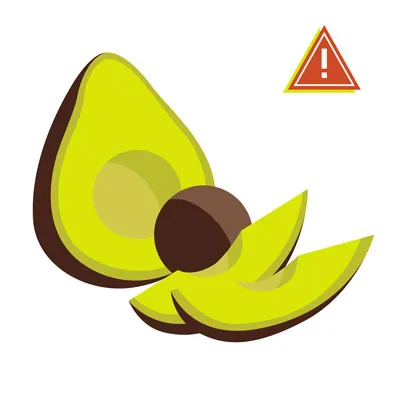 Ripe avocado half, illustrating a potentially harmful food that dogs should not consume.
Ripe avocado half, illustrating a potentially harmful food that dogs should not consume.
Avocados are generally not recommended for dogs. While the exact toxicity can vary, avocados contain a substance called persin, which is known to cause problems in several animal species. Although documented cases of severe avocado poisoning in dogs are less common, some dogs have reportedly suffered myocardial damage after consumption. Additionally, an intact avocado pit presents a significant risk of gastrointestinal obstruction if swallowed, making it prudent to keep this fruit away from your canine companion.
4. Broccoli
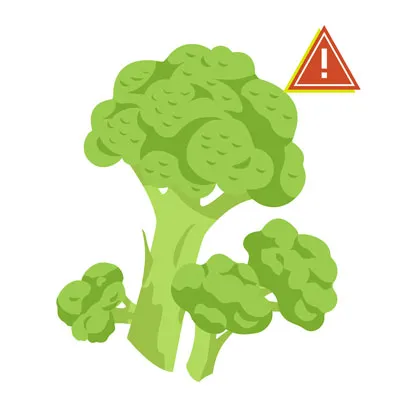 Fresh green broccoli florets, warning against potential harm to pets in large quantities.
Fresh green broccoli florets, warning against potential harm to pets in large quantities.
Broccoli contains isothiocyanates, compounds that can be harmful to pets in very large doses. While small, occasional amounts might be tolerated by some dogs, it’s generally best to err on the side of caution and opt for other healthier, safer vegetable treats. Furthermore, the stalks of broccoli can pose a choking hazard or cause gastrointestinal irritation if ingested, especially in smaller dogs.
5. Caffeine and Coffee Grounds
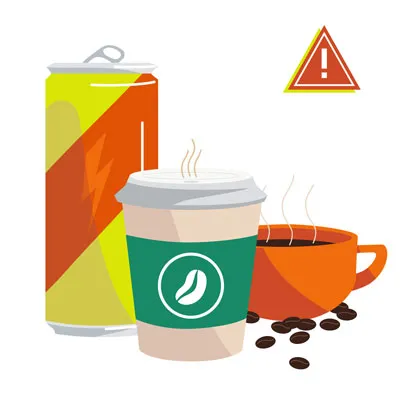 Coffee beans and grounds, illustrating caffeine's toxicity for dogs.
Coffee beans and grounds, illustrating caffeine's toxicity for dogs.
Caffeine, found in coffee, tea, energy drinks, and some medications, contains methylxanthines. These stimulants can cause a range of serious symptoms in dogs, including restlessness, hyperactivity, vomiting, diarrhea, tremors, seizures, abnormal heart rhythm, and can be fatal. Even small amounts, such as those found in discarded coffee grounds or tea bags, can trigger these adverse reactions.
6. Fatty Cuts of Meat (Chicken/Turkey Skin, Ham) and Bones
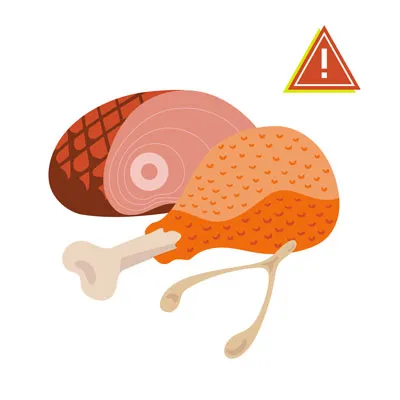 Various fatty meat cuts and bones, indicating the dangers of high-fat foods and splintering bones for dogs.
Various fatty meat cuts and bones, indicating the dangers of high-fat foods and splintering bones for dogs.
Feeding dogs fatty cuts of meat, such as chicken or turkey skin, ham, or heavily marbled beef, should be avoided. Their high fat content can precipitate acute pancreatitis, a life-threatening inflammatory condition of the pancreas that can lead to severe complications. Additionally, cooked bones, particularly poultry bones, are extremely dangerous. They can splinter easily, leading to choking, obstructions in the digestive tract, or even punctures of the stomach or intestines, which can result in fatal abdominal infections. For more on specific meat concerns, review what is the one meat dogs should not eat.
7. Chocolate
 Assorted chocolate bars and candies, symbolizing the highly toxic nature of chocolate for dogs.
Assorted chocolate bars and candies, symbolizing the highly toxic nature of chocolate for dogs.
Chocolate is one of the most widely recognized toxic foods for dogs and remains a frequent cause of pet poisonings. It contains theobromine and caffeine, both methylxanthines that dogs metabolize slowly. The darker and more bitter the chocolate (e.g., baker’s chocolate, dark chocolate), the higher the concentration of theobromine, making it more dangerous. Some sugar-free chocolates may also contain xylitol, an artificial sweetener that is highly toxic to dogs. Ingestion can lead to hyperactivity, vomiting, diarrhea, pancreatitis, abnormal heart rhythms, and seizures. Any amount of chocolate ingestion warrants immediate veterinary attention.
8. Grapes and Raisins
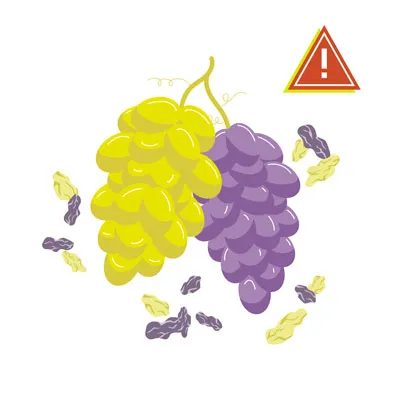 Fresh grapes and dried raisins, signifying their severe toxicity and kidney failure risk for canines.
Fresh grapes and dried raisins, signifying their severe toxicity and kidney failure risk for canines.
Grapes and raisins are notoriously dangerous for dogs, capable of causing acute kidney failure. The exact toxic substance is now believed to be tartaric acid, which is present in these fruits and highly harmful to canine kidneys. Even a few grapes or raisins can be enough to cause severe illness, with symptoms including vomiting, diarrhea, lethargy, loss of appetite, abdominal pain, and changes in urination (from increased thirst and urine output to complete absence of urine). Prompt veterinary intervention is critical if any amount is ingested.
9. Macadamia Nuts, Almonds, and Pistachios
 Pile of macadamia nuts, almonds, and pistachios, cautioning against their toxicity and choking hazards for dogs.
Pile of macadamia nuts, almonds, and pistachios, cautioning against their toxicity and choking hazards for dogs.
Macadamia nuts are highly toxic to dogs, though the precise mechanism of poisoning is not fully understood. Ingestion can lead to weakness, tremors, depression, vomiting, joint pain, and overheating. As few as six nuts can cause severe poisoning in a small dog. While other nuts like almonds and pistachios are not typically as toxic, they still pose risks. Their high fat content can lead to pancreatitis, and their size and hardness can make them choking hazards or cause gastrointestinal upset and blockages, especially if not shelled. Flavored or spiced nuts also contain additional ingredients that may be harmful.
10. Milk and Dairy Products
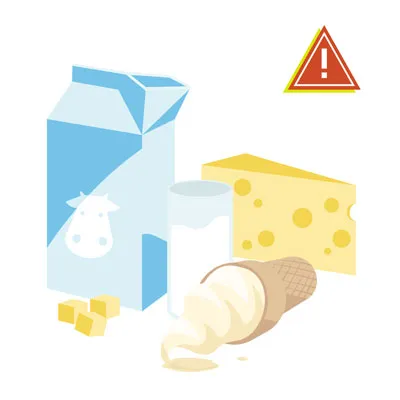 Glass of milk and dairy products, indicating potential lactose intolerance and digestive issues in dogs.
Glass of milk and dairy products, indicating potential lactose intolerance and digestive issues in dogs.
The ability of dogs to digest milk and dairy products varies greatly. Many adult dogs are lactose intolerant, meaning they lack sufficient lactase, the enzyme needed to break down lactose in milk. For these dogs, consuming milk or other dairy products can lead to digestive upset, including diarrhea, gas, and abdominal pain. High-fat dairy products like ice cream are particularly problematic due to their sugar and fat content, which can trigger pancreatitis. While small quantities of low-fat cheese might be acceptable for some dogs, it’s always best to introduce dairy cautiously and monitor for adverse reactions. As an alternative, try freezing small bites of safe fruits as a cool treat.
11. Mushrooms
 Assortment of wild mushrooms, emphasizing the general toxicity and risk of organ damage in dogs.
Assortment of wild mushrooms, emphasizing the general toxicity and risk of organ damage in dogs.
It is generally safest to avoid feeding your dog any type of mushroom. While culinary mushrooms from the grocery store might be safe after thorough washing and cooking, distinguishing between edible and toxic varieties can be extremely difficult, especially for wild mushrooms encountered outdoors. Many wild mushrooms contain potent toxins that can cause severe symptoms, including kidney and liver failure, vomiting, diarrhea, hallucinations, and damage to red blood cells. Given the high risk and difficulty in identification, it’s prudent to keep all mushrooms away from your canine companion.
12. Nutmeg and Cinnamon
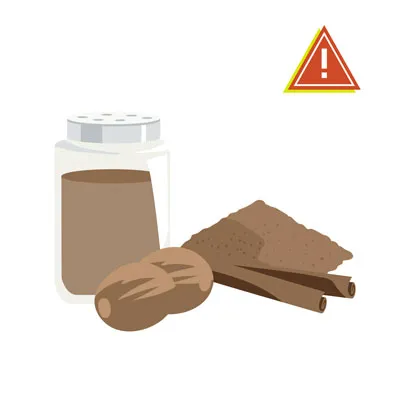 Nutmeg and cinnamon sticks, cautioning against the hallucinogenic and irritant effects on dogs.
Nutmeg and cinnamon sticks, cautioning against the hallucinogenic and irritant effects on dogs.
Nutmeg contains myristicin, a compound that can cause hallucinations, disorientation, rapid heart rate, high blood pressure, and severe vomiting in dogs. The effects are more pronounced with higher doses or in smaller dogs. It is crucial to prevent dogs from ingesting any foods spiced with nutmeg. Cinnamon, while not strictly toxic, can cause irritation to a dog’s mouth, leading to discomfort, coughing, and even difficulty breathing if inhaled in powder form. In large quantities, it can also lead to low blood sugar, diarrhea, and vomiting. Therefore, it’s best to avoid both spices.
13. Onions, Garlic, Chives, and Leeks
 Onions, garlic cloves, chives, and leeks, signifying the severe anemia risk for dogs.
Onions, garlic cloves, chives, and leeks, signifying the severe anemia risk for dogs.
All members of the allium family—including onions, garlic, chives, and leeks—are highly toxic to dogs and cats. These plants contain sulfoxides and disulfides, compounds that can damage red blood cells, leading to a condition called hemolytic anemia. Symptoms may not appear immediately and can include lethargy, weakness, pale gums, rapid breathing, vomiting, and dark urine. Onion and garlic powders, often found in many processed human foods (including baby food), are even more concentrated and thus more potent. Certain Japanese breeds, such as Akitas and Shiba Inus, are particularly sensitive, but these plants are dangerous for all dogs.
14. Salt
 Salt shaker and rock salt, warning about excessive sodium leading to tremors and seizures in dogs.
Salt shaker and rock salt, warning about excessive sodium leading to tremors and seizures in dogs.
Excessive salt intake can be very dangerous for dogs, disrupting the fluid balance in their cells. High levels of sodium can lead to a condition known as sodium ion poisoning, causing symptoms such as excessive thirst and urination, vomiting, diarrhea, lethargy, tremors, seizures, and even coma. Common sources of concern include salty snacks like potato chips, rock salt used for de-icing, or homemade play dough. Always ensure your dog has access to fresh water, and avoid giving them overly salted foods.
15. Spicy Food
 Red chili peppers and hot sauce, illustrating how spicy foods can cause digestive upset and pain in dogs.
Red chili peppers and hot sauce, illustrating how spicy foods can cause digestive upset and pain in dogs.
Spicy foods are generally not suitable for dogs. Ingredients like chili peppers or hot spices can irritate a dog’s mouth and digestive tract, leading to significant discomfort, vomiting, diarrhea, and potentially stomach ulcers. While not typically lethal, the pain and gastrointestinal upset can be severe, potentially necessitating a costly emergency veterinary visit. It’s always best to stick to bland, dog-friendly treats.
16. Sugar-Free Gum and Candy (Xylitol)
 Sugar-free gum and candies, emphasizing the extreme danger of xylitol for dogs.
Sugar-free gum and candies, emphasizing the extreme danger of xylitol for dogs.
Xylitol is an artificial sweetener commonly found in many sugar-free human products, including chewing gum, candies, certain baked goods, peanut butter, and even some toothpastes. In dogs, xylitol is rapidly absorbed and causes a sudden, severe drop in blood sugar (hypoglycemia), leading to weakness, loss of coordination, seizures, and collapse. In some cases, it can also cause acute liver failure, which can be fatal. Even a small amount, such as that found in a few pieces of gum, can be deadly for a medium-sized dog. Xylitol poisoning cases are unfortunately on the rise, making it imperative to keep all products containing this sweetener strictly out of reach.
17. Tomatoes and Raw Potatoes
 Unripe green tomatoes and raw potatoes, indicating toxicity due to solanine.
Unripe green tomatoes and raw potatoes, indicating toxicity due to solanine.
Tomatoes and potatoes fall into a category of foods that are safe in some forms but unsafe in others. Ripe red tomatoes, in moderation, are generally considered safe. However, the green parts of the tomato plant (leaves, stems) and unripe green tomatoes contain solanine, a toxic compound that can cause gastrointestinal upset, lethargy, and weakness in dogs. Similarly, baked or boiled potatoes without additives are usually safe in small quantities. But raw potatoes, particularly green ones, also contain solanine, making them toxic. Always ensure any potatoes given to your dog are thoroughly cooked and free of green spots or sprouts.
18. Tobacco Products
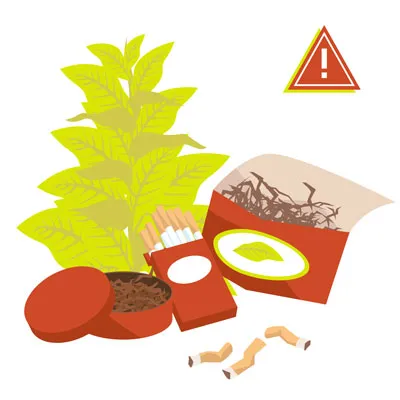 Cigarettes and tobacco products, illustrating the severe nicotine poisoning risk for dogs.
Cigarettes and tobacco products, illustrating the severe nicotine poisoning risk for dogs.
Tobacco and any products containing nicotine are extremely dangerous and unhealthy for dogs. Nicotine is a potent toxin that can cause a wide range of severe symptoms, including vomiting, diarrhea, rapid or labored breathing, agitation, abnormal heart rate, wobbliness, muscle weakness, high or low blood pressure, tremors, and seizures. More significant exposure can lead to blue gums, coma, and can ultimately be fatal. Dogs are naturally curious and may ingest discarded cigarettes, cigarette butts from ashtrays, or even nicotine pouches. If your dog consumes any tobacco product, immediate veterinary care is essential.
19. Yeast and Raw Dough
 Raw dough rising in a bowl, highlighting the dangers of expansion and alcohol toxicity for dogs.
Raw dough rising in a bowl, highlighting the dangers of expansion and alcohol toxicity for dogs.
Yeast and raw dough pose serious threats to dogs. Raw dough can continue to rise and expand in a dog’s warm stomach, leading to severe abdominal pain, bloating, and potentially life-threatening gastric dilatation-volvulus (GDV), a condition where the stomach twists. Furthermore, the yeast and sugar in raw dough ferment, producing alcohol that can be absorbed into the bloodstream. This can cause alcohol toxicity, which requires immediate medical intervention and can quickly become fatal.
20. Raw Meat
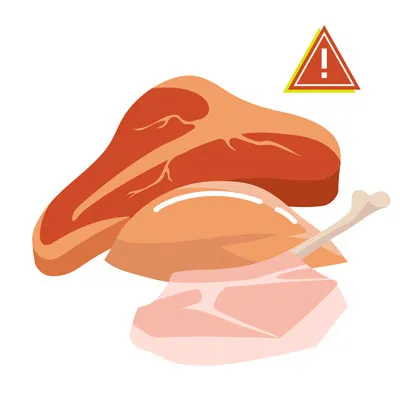 Raw cuts of meat, cautioning against bacterial contamination and choking hazards for dogs.
Raw cuts of meat, cautioning against bacterial contamination and choking hazards for dogs.
Never feed your dog raw or undercooked meat. While some proponents advocate for raw diets, the risks associated with feeding raw meat are significant and widely acknowledged by veterinary organizations. Raw meat can harbor dangerous bacteria such as Salmonella, E. coli, and Listeria, which can cause severe gastrointestinal illness in dogs (and can also be transmitted to humans). Additionally, raw meat often contains bones, which can splinter and cause choking, internal injuries, or obstructions.
21. Rhubarb
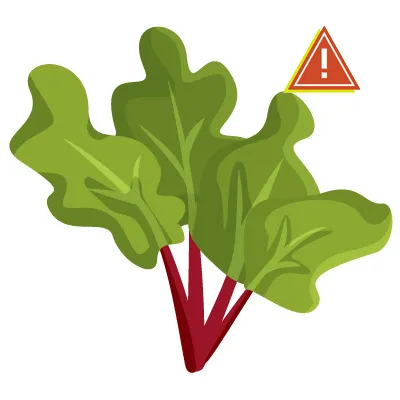 Fresh rhubarb stalks, indicating the presence of soluble oxalate crystals and kidney risk for dogs.
Fresh rhubarb stalks, indicating the presence of soluble oxalate crystals and kidney risk for dogs.
Rhubarb, a common ingredient in human desserts, is not safe for pets. Its leaves, and to a lesser extent the stalks, contain soluble calcium oxalate crystals. If ingested in sufficient quantities, these crystals can bind with calcium in the body, leading to a dangerous drop in blood calcium levels (hypocalcemia) and potentially causing acute renal failure. Symptoms can include tremors, weakness, excessive drooling, bloody urine, changes in thirst and urination patterns, and vomiting.
22. Star Fruit
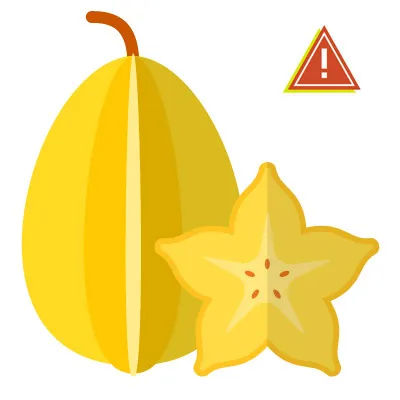 Sliced star fruit, cautioning against soluble oxalate crystals similar to rhubarb.
Sliced star fruit, cautioning against soluble oxalate crystals similar to rhubarb.
Similar to rhubarb, star fruit also contains soluble calcium oxalate crystals. For this reason, it should not be given to dogs. Ingestion can lead to similar symptoms and risks of kidney damage as seen with rhubarb. It’s best to avoid letting your dog snack on this exotic fruit.
23. Flavored Water and Seltzer Water
 Carbonated seltzer water in a glass, advising against flavored or fizzy drinks for dogs.
Carbonated seltzer water in a glass, advising against flavored or fizzy drinks for dogs.
When it comes to beverages for your dog, plain, fresh, clean water is always the safest and best option. Flavored waters and seltzer water often contain added ingredients that can be detrimental to pups, including sugars, artificial sweeteners (like xylitol), or excessive salt. While plain seltzer water might not be acutely toxic in very small amounts, the carbonation can cause gas and bloating, leading to discomfort. It is always best to stick to simple, unflavored water to ensure your dog’s hydration needs are met without any hidden risks.
Safe and Healthy Human Foods for Dogs
While the list of what food cannot be given to dogs is extensive, many human foods are perfectly safe and even beneficial when offered in moderation. These can be excellent additions to your dog’s diet as occasional treats, offering a variety of nutrients and flavors. Some of the most popular and safest options include dehydrated chicken or beef (in very small, plain quantities), apples (without the core and seeds), green beans, and carrots.
Here’s a guide to some popular human foods that your dog can safely enjoy, helping you diversify their treat options responsibly.
1. Apples, Oranges, and Bananas
 Fresh apples, oranges, and bananas, indicating safe fruit options (without seeds/peels) for dogs.
Fresh apples, oranges, and bananas, indicating safe fruit options (without seeds/peels) for dogs.
- Apples: The fleshy part of apples, thoroughly cored and seeded, is a great crunchy treat. Ensure all seeds are removed due to their cyanide content. Apples are a good source of vitamins A and C, and fiber.
- Oranges: Small amounts of peeled, seedless oranges can be given to dogs. They are rich in Vitamin C, but the high sugar content means moderation is key.
- Bananas: Bananas (peeled) are a good source of potassium, vitamins, and fiber. They should be given in moderation due to their sugar content.
2. Blueberries and Blackberries
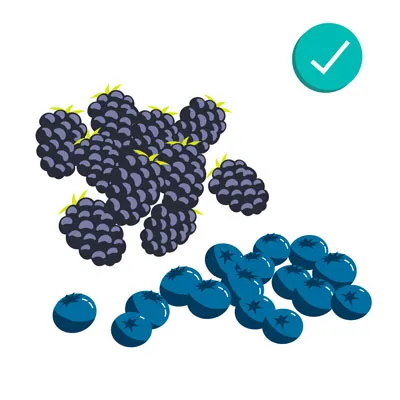 Bowl of fresh blueberries and blackberries, highlighting their antioxidant benefits for dogs.
Bowl of fresh blueberries and blackberries, highlighting their antioxidant benefits for dogs.
These small berries are fantastic, antioxidant-rich treats for your dog. Blueberries and blackberries are packed with vitamins, fiber, and phytochemicals that contribute to overall health. They are low in calories and can be given fresh or frozen, making them a refreshing snack.
3. Cantaloupe, Mango, Peaches, Pears, Pineapples, and Watermelons
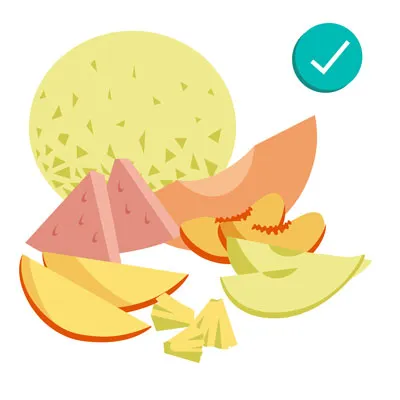 Assortment of various fruits like cantaloupe, mango, and watermelon, signifying safe fruity treats for dogs when prepared correctly.
Assortment of various fruits like cantaloupe, mango, and watermelon, signifying safe fruity treats for dogs when prepared correctly.
A wide variety of fruits can be safely enjoyed by your dog, offering different textures and flavors.
- Cantaloupe: A good source of water, vitamins A and C. Remove the rind and seeds.
- Watermelon: Mostly water, making it a hydrating treat, especially on warm days. Always remove the rind and all seeds (including the pale seeds in “seedless” varieties) to prevent choking and digestive issues.
- Mangoes, Peaches, Pears, and Pineapples: These are also safe in moderation. Crucially, always remove the large pits, seeds, and tough cores before offering these to your pup to avoid choking hazards and toxic compounds (in pits).
4. Carrots, Cucumber, and Celery
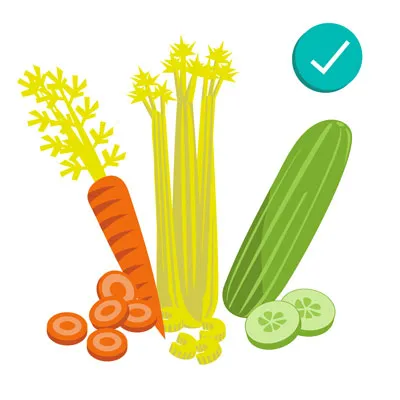 Fresh carrots, cucumber slices, and celery sticks, emphasizing low-calorie, healthy vegetable options for dogs.
Fresh carrots, cucumber slices, and celery sticks, emphasizing low-calorie, healthy vegetable options for dogs.
These “three C’s” are excellent, low-calorie options for dogs, especially those needing to watch their weight.
- Carrots: Crunchy, tasty, and good for dental health. Rich in Vitamin A.
- Cucumbers: Mostly water, very low in calories, and full of vitamins and minerals.
- Celery: Offers a satisfying crunch and can even help freshen breath.
5. Cheese
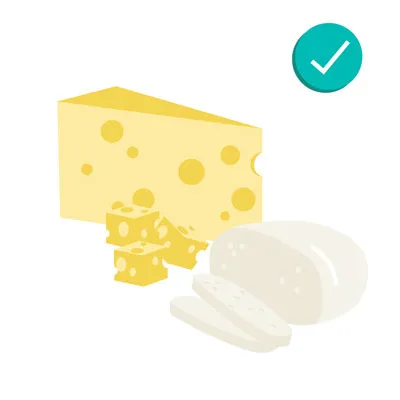 Small blocks of cheese, indicating suitability as a treat in small, low-fat quantities for dogs.
Small blocks of cheese, indicating suitability as a treat in small, low-fat quantities for dogs.
While dogs should generally avoid large amounts of milk and high-fat dairy, small quantities of cheese can be an acceptable treat if your dog isn’t lactose intolerant. Opt for lower-fat varieties like mozzarella or cottage cheese, and offer sparingly. Consult your veterinarian for the best type and portion size.
6. Eggs
 Cooked eggs in a pan, suggesting a safe, protein-rich food for dogs when fully prepared.
Cooked eggs in a pan, suggesting a safe, protein-rich food for dogs when fully prepared.
Fully cooked eggs are a safe and nutritious treat for dogs. Scrambled or boiled eggs (plain, without seasonings, butter, or oil) can provide a good source of protein and can even help soothe an upset stomach. Avoid raw eggs due to the risk of salmonella and biotin deficiency.
7. Peanuts, Peanut Butter, and Cashews
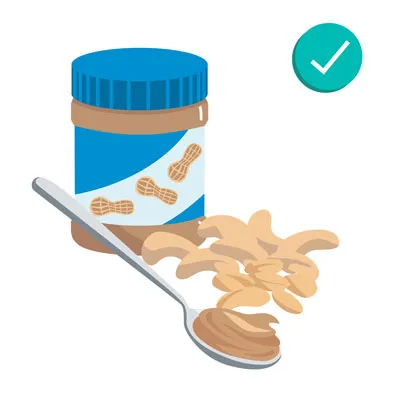 Shelled peanuts, creamy peanut butter, and cashew nuts, showing safe nut options for dogs in moderation.
Shelled peanuts, creamy peanut butter, and cashew nuts, showing safe nut options for dogs in moderation.
- Peanuts and Cashews: These nuts are safe for dogs in small, unsalted, unflavored quantities. Due to their high fat content, they should be given sparingly.
- Peanut Butter: A popular dog treat, peanut butter is a good source of protein and healthy fats in moderation. Crucially, always choose unsalted, natural peanut butter and absolutely avoid any variety containing xylitol, which is highly toxic to dogs.
8. Popcorn and Corn
 Fresh corn on the cob and air-popped popcorn, showing safe grain options when unseasoned.
Fresh corn on the cob and air-popped popcorn, showing safe grain options when unseasoned.
- Popcorn: Air-popped, plain, unsalted, and unbuttered popcorn can be a fun treat. Ensure all unpopped kernels are removed to prevent choking.
- Corn: Removed from the cob, plain corn kernels are acceptable for dogs. Avoid corn on the cob as the cob itself can cause choking or intestinal blockage.
9. Coconut and Honey
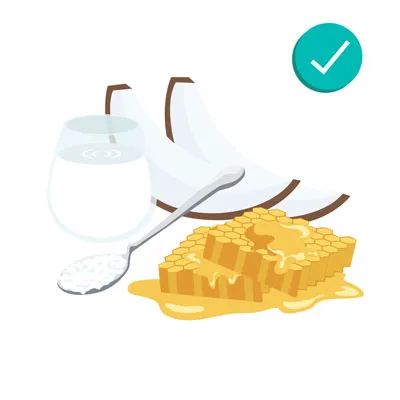 Fresh coconut halves and a jar of honey, indicating safe natural treats for dogs in small amounts.
Fresh coconut halves and a jar of honey, indicating safe natural treats for dogs in small amounts.
- Coconut: Small amounts of fresh coconut flesh (without the furry shell, which is a choking hazard), coconut milk, or coconut oil are generally safe. Coconut contains lauric acid and may offer some health benefits. However, some dogs may experience digestive upset, so introduce it cautiously. Avoid coconut water, as it’s not safe for dogs.
- Honey: In moderation, honey is safe for dogs and provides vitamins, minerals, and antioxidants. It’s a natural sweetener but should be given sparingly due to its sugar content.
10. Shrimp and Fish
 Cooked shrimp and fish fillets, indicating safe seafood options for dogs when prepared plainly.
Cooked shrimp and fish fillets, indicating safe seafood options for dogs when prepared plainly.
- Shrimp: Plain, fully cooked shrimp, with the shell, head, tail, and legs removed, is a great protein-rich treat. Avoid seasoned, salted, or buttered shrimp.
- Fish: Plain, fully cooked, and boneless fish like salmon and sardines are excellent sources of omega-3 fatty acids. Limit fish to no more than twice a week to avoid excessive mercury intake. Plain, canned tuna packed in water (not oil) is also safe in moderation.
11. Turkey
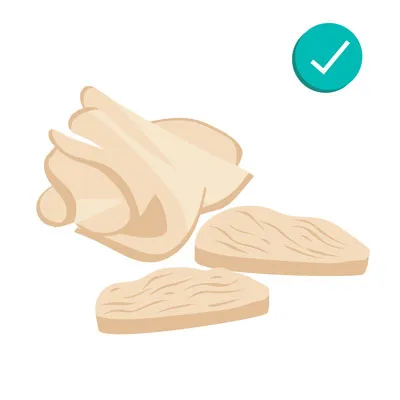 Cooked turkey meat slices, emphasizing a lean, safe protein source for dogs when unseasoned.
Cooked turkey meat slices, emphasizing a lean, safe protein source for dogs when unseasoned.
Plain, cooked turkey meat, with all skin, fat, and bones removed, is a healthy and safe source of protein for dogs. Offer small, unseasoned bites as a delicious treat. Always ensure it’s thoroughly cooked and completely free of any seasonings or salt.
12. Grains, Wheat, and Quinoa
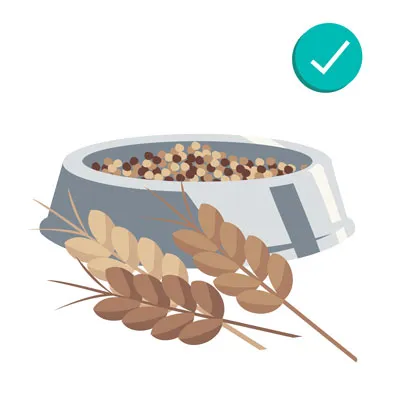 Bowl of various grains including wheat and quinoa, indicating suitability for dogs without allergies.
Bowl of various grains including wheat and quinoa, indicating suitability for dogs without allergies.
Contrary to some popular beliefs, a little bit of wheat, grains, or quinoa is generally fine for dogs unless they have a specific allergy or intolerance. Quinoa, in particular, is a nutritious grain, often considered a healthier filler option than many others. Monitor your dog for any allergic reactions when introducing new grains.
13. Green Beans
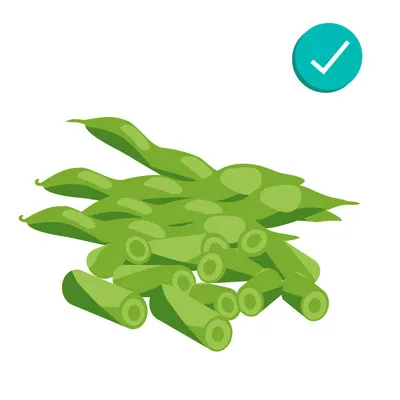 Fresh green beans, highlighting a healthy, versatile vegetable option for dogs.
Fresh green beans, highlighting a healthy, versatile vegetable option for dogs.
Green beans are a popular and highly recommended vegetable for dogs. They are safe, tasty, and healthy, whether served raw, steamed, or from a can (ensure canned varieties are plain with no added salt or spices). They are a great source of fiber and vitamins and are low in calories. Cut them into small, bite-sized pieces to prevent choking.
What Dogs Are Most at Risk if They Consume Toxic Foods?
While preventing all dogs from ingesting toxic foods is paramount, certain factors can increase a dog’s vulnerability and the severity of their reaction to harmful substances. Understanding these risk factors can help owners be even more vigilant.
- Small Breeds vs. Large Breeds: Smaller dogs are generally more susceptible to the effects of toxic substances due to their lower body weight. A dose of a toxin that might cause mild symptoms in a large breed could be lethal for a small dog. This is particularly true for items like chocolate, where the toxic compound’s concentration per pound of body weight becomes critical.
- Puppies: Young dogs have less developed digestive systems and immature immune responses, making them more vulnerable to adverse reactions from certain foods. Their curious nature also makes them more prone to ingesting questionable items.
- Elderly Dogs: Older dogs may be at higher risk due to potentially compromised organ function or other pre-existing health conditions. Their bodies may not process or eliminate toxins as efficiently as those of younger, healthier adults.
- Dogs with Pre-existing Conditions: Dogs suffering from underlying health issues such as diabetes, kidney disease, liver disease, or gastrointestinal sensitivities are at a significantly higher risk. Their bodies may struggle to cope with the added stress of a toxic substance, exacerbating their existing conditions or leading to more severe complications.
How to Prevent Dogs from Eating Toxic Foods
Accidents can happen, but proactive measures are crucial to minimize the risk of your beloved canine companion getting into unsafe human food. Here are essential steps for prevention:
1. Store Foods Out of Reach
The most effective prevention strategy is to keep all dangerous foods completely inaccessible to your dog. This means storing toxic items on high shelves, in secure pantries, or in cabinets with child-proof latches that your pup cannot open. Remember that dogs are resourceful; if they can smell it, they might try to get to it. Never leave potentially harmful foods unattended on countertops or low tables.
2. Avoid Feeding Dogs from Your Plate or While Cooking
Establish a strict rule: do not feed your dog directly from your plate or offer them scraps while you are cooking. This practice not only reinforces begging behavior but also increases the risk of inadvertently giving them something harmful. It is safest to only give your dog treats that are specifically formulated and approved for canine consumption.
3. Educate Family Members and Guests
Ensure everyone in your household, including children, understands the dangers of feeding human food to your dog. Educate guests about the specific foods that are off-limits and politely ask them not to sneak any treats to your pet, no matter how much your dog begs. Clear communication is key to maintaining a safe environment.
4. Be Extra Cautious During Holidays and Gatherings
Holidays and social gatherings often involve an abundance of human food, many of which can be toxic to dogs. The festive atmosphere can also lead to distractions, making it easier for a dog to sneak a bite. During these times, be extra vigilant. Consider confining your dog to a separate, safe room or crate during meals or when food is being prepared and served, especially if there are many people who might not be aware of the rules.
If despite your precautions, your dog eats something toxic, being prepared can make all the difference. Keep emergency contact information readily accessible, including your veterinarian’s number, the nearest 24/7 emergency veterinary clinic, and a pet poison control hotline.
What to Do if Your Dog Eats Something Toxic
If you suspect your dog has ingested a toxic food, immediate action is crucial. Time is often a critical factor in the success of treatment and recovery.
Firstly, be familiar with the common symptoms of food toxicity. These can vary widely depending on the substance ingested but often include:
- Lethargy or unusual hyperactivity
- Vomiting (sometimes with blood)
- Diarrhea (which may also contain blood)
- Excessive drooling
- Loss of appetite
- Abdominal pain or a bloated, hard-feeling stomach
- Tremors, seizures, or disorientation
- Weakness or collapse
- Changes in breathing or heart rate
If you notice any of these symptoms or strongly suspect ingestion, follow these steps:
- Call Your Veterinarian or a Pet Poison Control Center Immediately: Do not wait for symptoms to worsen. Have the contact information readily available. This is the most important step.
- Provide All Relevant Information: Be prepared to tell them:
- The type of food your dog ate.
- The estimated amount consumed.
- The approximate time of ingestion.
- Your dog’s breed, age, weight, and any existing medical conditions.
- Any symptoms your dog is currently displaying.
- Do Not Induce Vomiting Unless Directed: Unless specifically instructed by a veterinarian or poison control expert, do not attempt home remedies or try to induce vomiting. In some cases, inducing vomiting can be more harmful than the toxin itself (e.g., if the substance is corrosive, or if your dog is already showing neurological symptoms and could choke).
- Follow Their Instructions Precisely: They will provide the best course of action, which may include bringing your dog to the clinic immediately.
Conclusion
Understanding what food cannot be given to dogs is a fundamental aspect of responsible pet ownership. From common pantry staples to festive holiday treats, many human foods pose significant risks due to the unique way canine bodies process certain substances. Maintaining vigilance, educating your household, and adhering to strict food storage practices are your primary defenses against accidental poisonings. Remember, your dog relies on you to make safe dietary choices for them, so always prioritize their health and well-being.
While the list of forbidden foods is extensive, there are also numerous safe and healthy human foods that can be shared with your furry friend in moderation. Explore the list of safe options and discover what your dog enjoys as a healthy treat. If you ever find yourself unsure about a particular food or suspect your dog has ingested something harmful, do not hesitate to consult your veterinarian immediately. Their expertise is invaluable in safeguarding your pet’s health.
For added peace of mind, consider investing in pet insurance. Services like Dog Care Story’s recommended plans can help cover unexpected veterinary costs associated with accidental poisonings or other health emergencies. Furthermore, having access to a 24/7 Pet Helpline, often included with pet insurance policies, provides immediate expert advice whenever you’re concerned about your pet’s health. By staying informed and prepared, you can help ensure your dog lives a long, healthy, and safe life.
References
- Parker, H. (2023, May). Top 10 dog poisons. WebMD.
- Colorado State University. (2023, October). What happens if a dog eats chocolate?
- American Kennel Club. (2024, March). Fruits and vegetables dogs can or can’t eat.
- Klein, J. (2023, July). What to do if your dog drinks alcohol. American Kennel Club.
- Joy, H. (2022, December). Can dogs eat apples? PetMD.
- Koschalk, K. (2023, July). Can dogs eat plums? Chewy.
- Hayes, C. (2024, September). Avocado (Persea spp) Toxicosis in Animals. Merck Veterinary Manual.
- ASPCA. (n.d.). People foods to avoid feeding your pets.
- American Kennel Club. (2024, March). People foods dogs can and can’t eat.
- Ardente, A. (2023, January). Can dogs eat nuts? PetMD.
- Mitchell, S. C. (2024, January). Can dogs drink milk? PetMD.
- Morrison, B. J. (2023, November). Can dogs have nutmeg? PetMD.
- Schmid, R. et al. (2024). Onion, garlic, chive, and leek poisoning in dogs. VCA Animal Hospitals.
- Burke, A. (2024, October). Can dogs eat tomatoes? American Kennel Club.
- Ripley, K. (2023, November). Can dogs eat potatoes? American Kennel Club.
- American Kennel Club. (2023, June). What to do if your dog eats a cigarette butt.
- Goldstein, L. (2024, July). Dough & dogs: Why it’s bad and what you can do. Preventive Vet.
- Pet Poison Helpline. (n.d.). Rhubarb.
- Logue, H. (n.d.). Can dogs drink carbonated water? Rover.
- Malmanger, E. (2024, February). What fruits can dogs eat? PetMD.
- Burke, A. (2022, August). Can dogs have green beans? American Kennel Club.
- CDC. (2024, April). About pet food safety.
